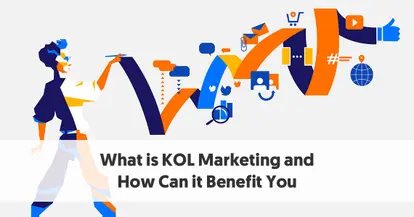We’ve regularly written about influencer marketing here. In influencer marketing, brands work with influencers to promote their products.
However, there are also similar types of marketing where firms work with specialist types of people to promote products on social media and encourage brand recognition. These include employee advocacy (firms partner with their staff for this purpose), and customer advocacy (where the people proving promotion are a firm’s existing customers).
Another specialist type of influencer is the Key Opinion Leader (KOL), and KOL marketing has become very popular in recent times. It has become a particularly notable form of marketing in China.
But what exactly is KOL marketing? That's the question we'll answer and explain everything to know about it.
KOL Meaning
KOL stands for "Key Opinion Leader." In marketing, KOLs are individuals who have established credibility and influence within a specific industry or niche. These leaders can be experts, professionals, or even celebrities whose opinions and recommendations hold significant weight among their followers.
Unlike traditional influencers, KOLs are often recognized for their deep knowledge and expertise in a particular field, making them trusted sources of information. In today's marketing landscape, KOLs play a crucial role in shaping consumer perceptions and behaviors. They are sought after for their ability to sway opinions and drive engagement through authentic connections with their audience.
Whether it's a renowned scientist discussing the latest healthcare innovations or a celebrated chef sharing culinary tips, KOLs possess the power to impact decisions and inspire action among their followers. Understanding the meaning of KOL is essential for businesses looking to leverage this influential group in their marketing strategies.
What is KOL Marketing?

Source:freepik.com
Key opinion leader (KOL) marketing involves brands collaborating with individuals who possess expert knowledge on a specific subject. This subject is typically related to the brand’s products or something that appeals to the brand’s target audience.
The main characteristics of KOL marketing are:
- Expert Knowledge: KOLs are individuals with deep expertise in a particular area.
- Relevant to Brand: The subject KOLs are knowledgeable about is usually tied to the brand’s products or interests of the brand's audience.
Most KOL marketing happens online. However, some KOLs have built their reputations through niche blogs or offline expertise. Therefore, KOLs can most often be found online on social media platforms like YouTube or niche blogs.
Note
KOL marketing existed before the internet and can be considered a subset of celebrity marketing.
Benefits of KOL Marketing

Source:freepik.com
Key opinion leaders (KOLs) hold tremendous respect and influence within their niches. They are recognized as experts in their fields, and their followers trust their opinions. This level of trust can significantly benefit brands that collaborate with KOLs.
Building Credibility and Influence
When a KOL positively mentions your brand or even just uses your product, it can be seen as a strong endorsement. Many followers will view this as a recommendation, which can lead them to try your product. If they have a positive experience, they may become loyal customers.
For example, imagine you manufacture sports cars. If a well-known motoring journalist writes a favorable review of your latest model, that article will reach a large audience. A portion of this audience may decide to purchase your car based on the review, increasing sales and boosting brand credibility.
Competitive Edge for Common Products
For brands with more affordable or commonplace products, KOL marketing can offer an even greater impact. In competitive markets with many similar products, a KOL’s endorsement can sway thousands or even millions of people to choose your product over others. The recommendation of a trusted expert can differentiate your brand in a crowded marketplace.
Creating Buzz and Engagement
KOL marketing can generate significant buzz, especially when KOLs use creative techniques like running competitions or launching campaigns such as a TikTok Hashtag Challenge. These innovative strategies can increase brand visibility and engage followers in a fun and interactive way.
High Return on Investment (ROI)
Like influencer marketing, KOL marketing has the potential for a high ROI compared to traditional marketing channels. However, it’s important to establish clear goals before launching any KOL campaigns. Your objectives could range from increasing brand awareness to driving traffic to your website. Setting measurable targets ensures that your KOL partnerships are aligned with your overall marketing strategy.
Reaching the Right Audience
One of the key advantages of KOL marketing is the ability to reach an audience that is united by shared interests. When you advertise on television or in newspapers, you know that many viewers or readers may have no interest in your product.
In contrast, when you collaborate with a KOL who resonates with your target market, you're reaching people who are likely to be genuinely interested in what you're offering.
Analyzing KOL Audiences
Before partnering with a KOL, it’s essential to evaluate their audience. By examining their previous posts or videos, you can get a sense of who follows them. Depending on the platform they’ve built their influence on, you might also have access to demographic and psychographic data about their audience.
This information helps ensure that their followers align with your target market, making your collaboration more effective.
Trust is at the Heart of KOL Marketing
The secret behind the success of KOL marketing is trust. KOL marketing only exists because many people trust key opinion leaders. KOLs make recommendations on their websites, video channels, or in their social statuses. These may be explicit, for example, when a KOL recommends a particular product or implicit, for instance, where people see a KOL using a product in action. People who respect the KOL trust them. They either believe their words when they make recommendations or their actions when they use a product.
This is very different from traditional advertising. If you examine an ad on television, radio, billboards, newspaper, or indeed any conventional source, you will either see a brand making claims about itself or alternatively, you will see paid actors making similar claims. Whether it be the brand or actors they employ makes no difference – people still see these ads as self-serving and artificial. They see brands clearly trying to exhort them to give up their hard-earned money to buy products that may or may meet their needs.
On the other hand, when consumers see people they trust, their key opinion leaders of choice, making the same claims (even merely using a product), they understand that the product must be worthwhile. They believe that it is worth taking a risk on trying the product themselves.
Word-of-mouth advertising works similarly to KOL marketing; it’s just that most people don’t have enough people listening to their mouths to make word-of-mouth marketing viable. You need the vast audiences offered by KOLs to make it worthwhile.
KOL Marketing is Particularly Strong in China
KOL marketing is particularly prevalent in China. Perhaps it has taken on there more than “normal” influencer marketing because Chinese social media is different from that in the West. Fewer specialist influencers who have gained their fame online. You are more likely to find Chinese key opinion leaders who have already established a reputation for being subject experts.
You can find Chinese KOLs in virtually any field. They are particularly prevalent in topics encouraging instruction or guidance. Some popular KOLs in mass interest niches have millions of followers.
These KOLs have built their reputation for being subject experts and are effectively the Chinese influencers of choice.
Many Chinese people are wary of information broadcast through traditional advertising mediums. KOLs add a layer of trust.
The most common way firms engage in KOL marketing in China is to either encourage user-generated content or to pay a KOL to use some of your promotional material, perhaps sharing a post you have created. User-generated content here usually involves a KOL reviewing your product or creating some other form of content that promotes your brand.
KOL marketing in China used different channels to the West. Rather than using YouTube, Facebook, or Instagram, Chinese KOLs are more likely to share information on Weibo, WeChat, or Zhihu.
Communicate with KOLs for Advice
While it may not always be easy to communicate with KOLs one-to-one, as they are busy people, it is worth taking any opportunities you may have. They are the experts for their audience, so they can provide you with much information about how to pitch your products to such people. Sure, they will probably tell you if they don’t like our product, too, but that could be invaluable feedback in itself, and help you make necessary improvements.
KOLs understand the likes and dislikes of their audience and will often provide you with useful insights on how to carry out a campaign.
Considerations for Working with KOLs
When analyzing the suitability of KOLs for your business, you should look at a range of factors. These include:
1. How relevant the KOL is to your target market. There is little point in working with somebody famous if their followers don’t match the types of people to whom you are hoping to market. You need to work with KOls whose areas of expertise match the topics that interest your target market.
2. The reach of a KOL. Effectively, you are looking at how many people will see a KOL’s promotional content on your behalf. Reach is not the most essential factor alone, however. KOLs in a broad subject will always have a larger audience than those who operate in a narrow niche.
3. The KOL’s engagement rate is critical. This shows you how involved they are with their audience. It gives an indication of how many people like and comment on their posts, and how many consider their posts worth sharing. Many KOLs in narrow niches, who may have limited reach, make up for this with high engagement rates.
Wrapping Up
KOL marketing offers a powerful way for brands to build credibility and reach highly targeted audiences through trusted experts. By partnering with key opinion leaders who have deep knowledge in their respective fields, brands can create authentic connections, generate buzz, and drive high engagement.
Whether through product endorsements, reviews, or creative campaigns, KOLs bring a layer of trust that traditional advertising often lacks, making them a valuable asset in any marketing strategy.
Frequently Asked Questions
What is KOL Marketing?
KOL Marketing, or Key Opinion Leader Marketing, involves collaborating with influential individuals who have established credibility and authority in specific fields to promote products or services, particularly prevalent in markets like China.
How does KOL Marketing differ from traditional influencer marketing?
While both strategies involve leveraging the influence of individuals to promote brands, KOL Marketing focuses more on experts with a deep understanding of their niche, whereas traditional influencer marketing may include a broader range of personalities without specialized knowledge.
What are the primary benefits of KOL Marketing?
KOL Marketing enhances brand awareness, increases credibility and trust among consumers, and allows for targeted marketing efforts that resonate with specific audiences.
How can businesses identify suitable KOLs for their campaigns?
Businesses should evaluate KOLs based on their relevance to the target market, reach (the number of followers), and engagement rates (how actively their audience interacts with their content) to ensure effective collaboration.
What types of content do KOLs typically create for brands?
KOLs may produce various types of content, including product reviews, tutorials, and promotional posts that encourage user-generated content or showcase the brand’s offerings in an authentic manner.





